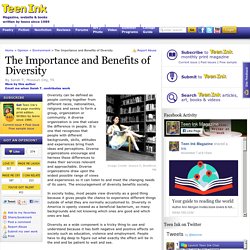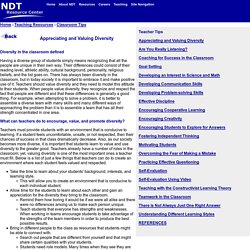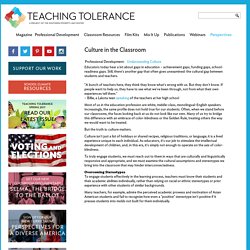

Earlychildhood NEWS - Article Reading Center. For a number of years teachers have become more interested in multicultural education, with the assumption that such approaches help children feel more welcomed, validated, integrated, and able to cooperate with others in their classroom (Allen, McNeill, & Schmidt, 1992; Bredenkamp, 1986; Byrnes & Kiger, 1992; Gollnick & Chin, 1994).

In my experience, in addition to these benefits, exposing young children to different cultures makes for a fun and exciting learning environment! There are four main approaches to teaching young children about different cultures. These are multicultural education, anti-bias curriculum, global education, and international education. Multicultural EducationPatty Ramsey (1987) defined multicultural education as a perspective which: Introduction: Teaching in Diverse, Standards-Based Classrooms. The Importance and Benefits of Diversity. Diversity can be defined as people coming together from different races, nationalities, religions and sexes to form a group, organization or community.

A diverse organization is one that values the difference in people. It is one that recognizes that people with different backgrounds, skills, attitudes and experiences bring fresh ideas and perceptions. Diverse organizations encourage and harness these differences to make their services relevant and approachable. Diverse organizations draw upon the widest possible range of views and experiences so it can listen to and meet the changing needs of its users. The encouragement of diversity benefits society. In society today, most people view diversity as a good thing because it gives people the chance to experience different things outside of what they are normally accustomed to. The different aspects of diversity are very important. Diversity can create curiosity. Promoting Respect for Cultural Diversity in the Classroom.
A primary goal of culturally responsive education is to help all students become respectful of the multitudes of cultures and people that they’ll interact with once they exit the educational setting.

This can be a daunting task for the educator, given that the world at large is infinitely more complex and diverse than the microcosmic environment that the student inhabits. In typical educational and social settings there is a marked tendency for students to exhibit classic in-group/out-group behaviors. In general, most students are comfortable interacting with people, behaviors, and ideas that they are familiar with but react with fear and apprehension when faced with the unfamiliar. Among its other goals, culturally responsive instruction aims to teach students that differences in viewpoint and culture are to be cherished and appreciated rather than judged and feared. Using a culturally-centered instructional approach can help facilitate cultural pride among diverse students. Diversity. Appreciating and Valuing Diversity Diversity in the classroom defined Having a diverse group of students simply means recognizing that all the people are unique in their own way.

Their differences could consist of their reading level, athletic ability, cultural background, personality, religious beliefs, and the list goes on. There has always been diversity in the classroom, but in today society it is important to embrace it and make positive use of it. Teachers should value diversity and they need to model this attitude to their students. Teaching Tolerance - Diversity, Equity and Justice. Educators today hear a lot about gaps in education – achievement gaps, funding gaps, school-readiness gaps.

Still, there's another gap that often goes unexamined: the cultural gap between students and teachers. "A bunch of teachers here, they think they know what's wrong with us. But they don't know. If people want to help us, they have to see what we've been through, not from what their own experiences tell them. " – Billie, a Lakota teen speaking of the teachers at her high school Most of us in the education profession are white, middle-class, monolingual-English speakers.
But the truth is: culture matters. Culture isn't just a list of holidays or shared recipes, religious traditions, or language; it is a lived experience unique to each individual. Hear elementary school teacher, Diane Holtam, speak about how she works with other teachers to disabuse stereotypic notions of Asian American students' abilities. Look For: Go Deeper: You're Asian, How Could You Fail at Math? Reflect On: Look for: